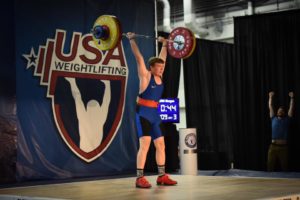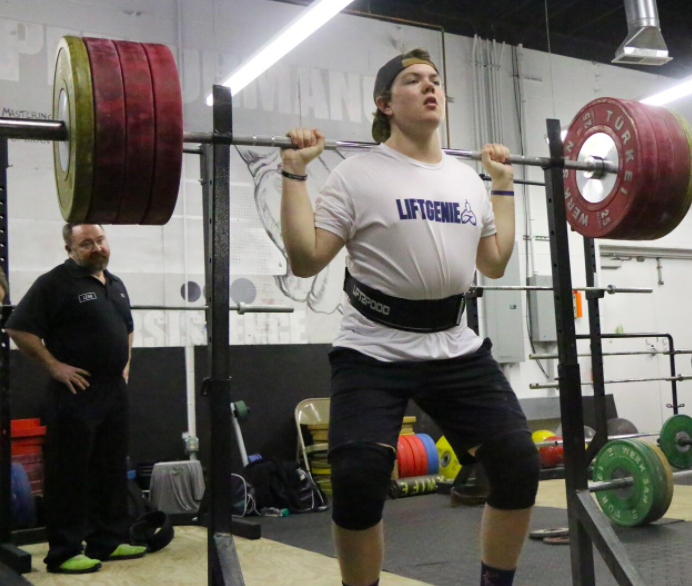I’m at the inaugural USA Weightlifting Symposium in Chicago, IL. I arrived on Thursday to assist with the USA Level I Certification, also known as the Sports Performance Certification. My favorite part so far is talking with the ambitious attending coaches. The most common question I am receiving is about the approach I am taking with my 14-year-old freak, Morgan McCullough. Of course they ask about Nathan Damron as well, but I think having a 14-year-old squat 242kg/533lb simply blows their mind.
When I am at these events, it’s always a reminder of just how lucky I really am. I get so used to seeing Nathan squat 320kg and Morgan clean and jerk 170kg that I get too accustomed to the whole thing. I’m spoiled as a strength and weightlifting coach. When I am at events like this, I realize that fact more and more. So what is my approach to coaching Morgan? What about Ryan, Jared, and Hannah – who are all of my top youth athletes? The answer is really the same for all of them.

However, for this article I will focus on Morgan, since he is the athlete I am getting asked about the most. Here’s the thing: there aren’t a lot of precedents set for coaching athletes like CJ Cummings, Harrison Maurus, or Morgan McCullough, so we are doing our best as coaches. All I can do is use the information I have received from school, recent research, and my own experience.
This article is being written to help all of you with your approach to coaching youth athletes. It’s also designed to give you my insight for coaching freak youth athletes. I am going to explain the major rules I follow, and I hope that this gives some of you some insight to help with your own athletes.
Like I said, we have four youth who could be considered international-level athletes. The rules I am going to explain are the same rules I use to coach each of them. Most of you might know Morgan, but we have several youth who we hope to one day reach the ultimate Olympic level.
1. Movement is Superior
At a young age you can’t sacrifice movement to lift a bit more weight. We are planning for 2024 for most of these young ones, so we don’t have to be anywhere near peaked for a long time. Yes, we want to get strong and make some strength progress, but perfecting movement is more important. If these athletes develop bad habits now like early arm bend or forward movement off the floor, these habits will be with them the rest of their careers. The goal is to perfect movement early on, so the focus can be on strength and refining movement when it’s time to be at peak performance.
2. General Physical Preparedness
I am trying to create incredible athletes early on in their career. I want them all to be able to run, jump, roll, and bend. Everyday my athletes are performing types of GPP. They are running, pushing sleds, jumping, and practicing gymnastics. Sometimes Coach McCauley will tell them to go outside and play. That’s what they do. They go out on the turf and back flip, walk on their hands, and sprint. We recently purchased a new basketball goal, and that was the best purchase that I have made in a long while. Almost everyday, my young ones along with the older athletes go outside and play hoops. You would be amazed at how high my boys and girls can jump.
This athleticism will help them become the best weightlifters in the world. They will learn how their bodies move throughout space, which will help them make those world class snatches and clean and jerks later in life. Not to mention this will help them create durable structures in their bodies that will come in handy later in their careers when the volume starts to increase.
3. Work Capacity
Work capacity goes right along with GPP. Look, I am not creating lazy athletes. I will leave that to the coaches I am beating. Morgan might very well be a heavyweight someday, but he will not be a lazy, out of shape heavyweight. He will be able to perform the work required to become the best weightlifter in the world. Will he be the best in the world? You will need to ask him. He’s the one who has to actually lift the weight required, but I am going to give him all the tools required. The same is true for all of my incredible youth.
At some point there will be a few athletes around the world who have the genetics to become the best. At that point the athlete who is able to perform the most optimal work will be the one who is able to surpass the rest. I am not going to let my athletes get outworked. To beat them, you will flat out need to be better than they are because you are not going to be able to perform more work than they will.
4. Communication
I am blessed in the ability to create solid relationships with my athletes. Morgan is actually my godson, so I have a little advantage in his case. However, I love all of my young ones. That opens the line of communication with my athletes, which makes it easy for me to know when they are beat up or feeling great. I always believe my athletes because I know they’re not lazy. If my athletes are experiencing tweaks, we deal with those tweaks. I never push them through injuries. If their backs hurt, we are backpedaling and dealing with that injury.
We have six years until the 2024 Olympics. We don’t have the ability to qualify for those Olympics now, but we can hurt our athletes so that 2024 is impossible. I am not going to do that. I have no problem with dropping back and punting. Not only will I back off on their training volume, but we also have a pretty good network of chiropractors and physical therapists to keep our athletes performing at 100%. If you are a strength coach or weightlifting coach, I recommend staying in yout lane. You are not a PT or chiro, so don’t pretend to be. I always laugh when I see weightlifting coaches or strength coaches trying to adjust or perform manual therapy with their athletes.
5. Balanced Approach
Listen up on this section. Now we are going to get into programming a bit. When coaching youth athletes, you have to be aware of efficiency (technique), strength levels (squat, pulls, and presses), and muscular balance. This is where the art of coaching comes in to play. Here are a few questions to ask as your athletes are progressing:
- Are their competition lifts increasing with their strength increases?
- Is their strength increasing with the increases of their competition lifts?
- Are there muscular weaknesses on your athlete?
- Are there any asymmetries that need to be addressed?
You will constantly be working on one area or another. It’s like being a sculptor. You work a bit on one side, and then you need to make some adjustments on the other side. The key is tracking progress, efficiency, and muscular balance. In the Mash Mafia, we track all of these and more. We have a pretty cool test that we use for our athletes that will tell us most things we need to know. It’s the very same test that we use in our guide to muscular imbalances, No Weaknesses.
[thrive_leads id=’9063′]
It will tell us the efficiency of our competition lifts, which means that we track our athletes’ abilities to perform high intensities with the competition lifts as their strength markers increase like squats, pulls, and pushes. For example, your athlete should be able to clean and jerk 75% of their back squat. This varies for each athlete, but this is a good starting point. Eventually, you will notice a certain ratio for each individual athlete.
These are the top five elements I focus on. However, you should make sure that they are getting more dialed in with their nutrition and recovery as time goes on. There is also one big element that way too many people avoid, and that’s our job as coaches to help these young men and women to become better humans. I want my athletes to go on in life to become incredible husbands, wives, parents, friends, employees, and coworkers. This is more important because their time after weightlifting will hopefully last a lot longer than their lifting careers. Nothing makes me happier than seeing my athletes with happy marriages and families.
I hope this article gives you some ideas of what I am doing with my young freaks. I truly love this team, and I could easily write a novel about our entire team. I hope all of you go out and create teams that are just as good. We can’t thank all of you enough for your continued support. We love training and competing, but none of this is possible without all of you. If you are reading this, you are a part of Team Mash Elite in my book. Thank you all so much!

Great article coach! Dave Tate talks a lot about the long term perspective as well and how most people are only working around 12 week cycles and not the years that becoming a great strength athlete actually takes. I appreciate the great content, thank you.